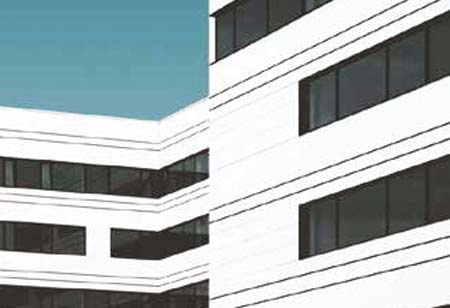Thank you for Subscribing to Construction Business Review Weekly Brief

Rebounding from COVID-19 in Construction and Lessons Learned in Healthcare Construction
Do we ever look in the mirror and ask ourselves, “What did we do before COVID-19?” As we plan for our construction projects today, it takes more effort, planning, and collaboration with our teams to be more creative with solutions.
The COVID-19 pandemic significantly impacted various industries, including construction and healthcare. Essential lessons must be learned from the challenges and innovations that emerged during this period as the world works toward recovery.
Resilience and Adaptability: The pandemic highlighted the importance of resilience and adaptability in construction and healthcare. Construction projects were either delayed or disrupted due to supply chain issues, labor shortages, and lockdown measures. Healthcare facilities had to rapidly adapt to changing patient needs, such as converting spaces into temporary hospitals and creating isolation units. Our initial changes within the hospital continuously modified and adapted as more information about COVID-19 became available.
Supply Chain Diversification: The construction industry learned the importance of diversifying supply chains to reduce dependency on a sole source. Shortages of materials like lumber and steel led to project delays and increased costs. Moving forward, construction companies should prioritize local suppliers and maintain a more robust inventory of critical materials. This is a complete mindset change from the past ten years, with construction teams focusing on “just-in-time deliveries” for projects without laydown areas or onsite storage capacities. Furthermore, from a customer standpoint, they no longer had unlimited options of material or color choices, which improved the timeline of making those selection decisions.
Digital Transformation: The adoption of digital tools and technologies in construction and healthcare accelerated due to the pandemic. Virtual meetings, Building Information Modeling (BIM), and remote collaboration became essential. Optimization of advanced planning tools and virtual simulations regarding infection control and patient flow layouts as part of healthcare construction became more prevalent. This transformation forced small to medium-sized companies to jump on board with technology, specifically the BIM coordination, and the industry successfully implemented these coordination sessions virtually.
Looking back on my career, I remember driving almost 90 minutes to attend an hour-long meeting and always thinking about the non-productive hours wasted traveling to and from the projects. However, there were always those meetings where the situation demanded the entire team to be in person, which virtual meetings cannot replace. Visiting the project team, walking the project in person, or working through issues at the site is invaluable. Our industry is still a personal business; we rely on relationships and cannot depend 100 percent on virtual meetings; otherwise, the connection will be lacking.
Health and Safety: The pandemic underscored the significance of health and safety protocols on construction sites and within healthcare facilities. Enhanced safety measures, including social distancing, sanitation practices, and personal protective equipment, will remain in place to prevent the spread of illnesses, primarily as we work around patient areas and through the flu season.
Flexibility in Facility Design: Healthcare construction shifted towards more flexible facility designs. Modular structures and adaptable spaces became crucial to respond to changing demands quickly.
Design considerations for isolation rooms, negative pressure environments, and flexible patient wards gained prominence.
Collaboration and Communication: Effective communication and collaboration were vital during the pandemic. In healthcare construction, close coordination between architects, contractors, and medical professionals was necessary to ensure that facilities met medical requirements while adhering to construction timelines. Construction and design teams had to put more effort into pre-planning the projects, investigating lead times, and other solutions to solve the supply chain issues the teams were facing.
Preparedness Planning: The healthcare sector must prioritize preparedness for future health crises. Designing healthcare facilities with surge capacity in mind and incorporating isolation and quarantine areas will prevent healthcare systems from becoming overwhelmed. As we plan current and future renovation projects, these questions are coming up in design. How will the facility manage the patients if there is another crisis and the team shuts down the isolation rooms?
For example, in September 2019, we broke ground on a new 106-room patient bed tower. In the middle of the project, the owner approached the team and requested that we figure out how to modify the existing design by adding 18 isolation rooms to prepare for the next pandemic.
Remote Work and Prefabrication: The pandemic encouraged the construction industry to explore remote work options and prefabrication techniques. Off-site construction and modular components can lead to faster project completion times and reduced disruptions. This construction solution is growing in the industry, and its application is becoming more widespread. As an industry, we are seeing owners increase their demand for prefabrication assemblies or Modular KPIs in their RFPs.
By embracing innovative technologies, fostering diverse collaboration, early partnerships, and prioritizing well-being, we have not only weathered the storm but have emerged stronger, more connected, and better prepared for the future.
Emphasis on Mental Health: The pandemic highlighted the importance of mental health for construction workers and healthcare professionals. Providing appropriate spaces and support systems for their well-being will become a focus in construction site planning and healthcare facility design.
Community Engagement: The pandemic reinforced the importance of community engagement and stakeholder involvement. Constructing healthcare facilities requires collaboration with local communities to address concerns, ensure accessibility, and foster a sense of ownership.
As construction and healthcare industries rebound from the challenges posed by the COVID-19 pandemic, integrating these lessons learned can contribute to more resilient, adaptable, and effective practices in the future. By embracing innovative technologies, fostering diverse collaboration, early partnerships, and prioritizing well-being, we have not only weathered the storm but have emerged stronger, more connected, and better prepared for the future. Let us carry forward the lessons learned during this time to continue fostering a culture of collaboration, innovation, and unity.








